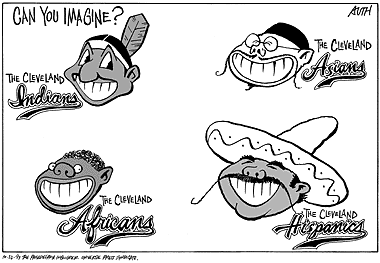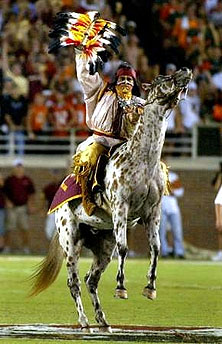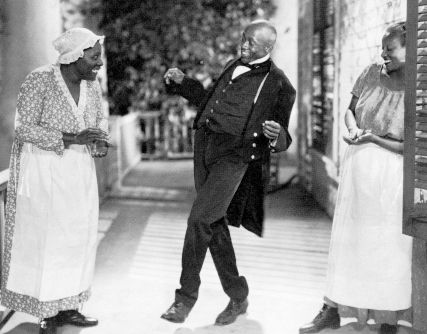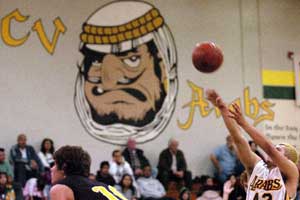 Another response to Team Names and Mascots:
Another response to Team Names and Mascots: Another response to Team Names and Mascots:
Another response to Team Names and Mascots:
Block That Mascot? Bite Your Tongue
By Marc Fisher
Thursday, November 17, 2005; B01
Earlier this week, my fellow tenant in this space, Courtland Milloy, used a parable about a football game between the Whiteys and the Darkies to force us to think about the Washington Redskins' name.
It was a strong appeal to our sense of fairness. But it was based on a fallacy.
We've all heard the pleas for sports teams to leave behind the derisive nicknames of another era. And perhaps we can agree that there's little defense for some names. Take, for example, the Southeastern Oklahoma State University Savages. (Women's teams: the Lady Savages. I kid you not.)
But, wait: Turns out that the chief of the Choctaw Nation defends the Savages. Instead of ripping the college for insensitivity, tribal officials are proud of the name and emphasize the school's support for the quarter of its students who are Indians.
Sometimes when you look beyond the easy slogans of activists, you find something more interesting: Most people simultaneously cherish history and want to do the right thing.
Two major studies show that while activists are busy suing teams, many Indians take no offense. A survey of Indians conducted in 2002 for Sports Illustrated found that 81 percent don't think high school or college teams should drop Indian nicknames. Asked about the Redskins, 75 percent said the name doesn't offend them. Last year, the University of Pennsylvania's Annenberg Election Survey found that 90 percent of Indians did not consider "Redskins" offensive.
But such matters ought not be settled solely by plebiscite. The real question is whether the trumped-up sensitivities of people who could be addressing, say, Indian poverty will be permitted to scrub away history at thousands of schools.
And let's not limit ourselves to Indian names, because this debate is about the role the past plays in our lives. Radicals want to pretend that without Indian names we are pure as — colorism alert! — freshly fallen snow. Surely, they say, we would never stand for teams using the names of other ethnicities.
But in Southern California last weekend, the Coachella Valley High School football team, the Arabs, beat the Indio Rajahs, 24-12. Their league includes the Palm Springs Indians and the Palm Desert Aztecs. In a less oppressively sensitive time, that was one heck of a place to be a sports headline writer.
California is still home, amazingly, to the Tarbabes of Compton High School, whose name never had any racial connotation (nearby Compton College's teams were the Tartars, so the high school adopted Tartar Babies, later shortened to Tarbabes.) In Texas, the Hereford Whitefaces were named for a breed of cattle.
Across this land, you'll find such school nicknames as the Elk Horn (Iowa) Danes, Sultan (Wash.) Turks and Man (W.Va.) Hillbillies. Those Arabs in Palm Springs, by the way, are named for immigrants who planted the area's cash crop, date trees. That's a slur?
The panicked response of academics desperate to avoid being tagged as racist poses a far greater threat than any team name could. Today's campaigns for verbal purity lace our society with fear and push us ever deeper into suppressing thought.
Last summer, the NCAA banned Indian names at 18 schools, lumping into the same pot not only Redmen and Fighting Sioux but also Chippewas and, yes, Indians (seven colleges). One of those schools, Indiana University of Pennsylvania, is in Indiana, Pa. Not only the team, but presumably the college and the town also need new names.
Speaking of inappropriate behavior, the NCAA has not cleaned its own house. Its headquarters is in — I can barely bring myself to type the offending letters — Indianapolis.
Florida State, helped by Gov. Jeb Bush's threat to sue the NCAA and by a hearty endorsement of the 'Noles' name by the Seminole Tribe, has won a reprieve. But too many schools are caving. Even before the ban, Indiana University had sought a compromise by keeping its Indians name and switching its mascot. The school hired a Manhattan (oh, my, another name that simply cannot stand) sports branding firm, and the Indian became — a bear.


Want to ban the Atlanta Braves' infernal tomahawk chop? Fine (though I kind of miss Chief Nokahoma). But the sins of the past cannot be erased by turning words into taboos. Didn't George Orwell teach us that?
© 2005 The Washington Post Company
Rob's reply
The next day I sent Fisher a message:
Marc,
I must've missed something. Where was the fallacy in Courtland Milloy's parable? If you found a fallacy, you didn't identify it in your response column. Instead, you talked about things unrelated to Milloy's main point: that "redskins" is a slur comparable to "darkies."
Rob Schmidt
Publisher
PEACE PARTY
The debate continues (1/3/06)....
Marc,
>> As I noted in the column, there are many team names that have ethnic derivations yet are neither meant nor taken as slurs. <<
Oh, I see. The "fallacy" you mentioned in the second paragraph of your column was the one you finally began to discuss in the eighth paragraph. After spending five paragraphs on unrelated points. Hmm...not exactly crystal-clear writing there.
So your examples include:
Arabs
Rajahs
Aztecs
Tarbabes
Whitefaces
Danes
Turks
Hillbillies
Let's see..."Rajah" is a title or position, not an ethnic group name. The Aztecs, like the Vikings, Trojans, and Spartans, are extinct, so no one's left to protest the use of their name. "Whiteface" is a breed of cow that only sounds like an ethnic group name. "Hillbillies" is a cultural or geographic designation that doesn't apply to any single ethnicity.
So your "many" examples boil down to four. All are from obscure high schools; none of them have the prominence or reach of a typical college or university. And the Coachella Valley Arabs actually HAVE drawn protests, as you'd know if you read the following:


Critics say it's time for the stereotypes to be retired
12:33 AM PST on Monday, December 12, 2005
By JEFF EISENBERG and MATT CALKINS / The-Press Enterprise
Walk through the halls of Coachella Valley High School and it's like stumbling into a scene from "The Arabian Nights."
A huge caricature of a snarling Arab wearing a headscarf welcomes visitors to the gymnasium. Lush date palms adorn the sprawling campus. Lavish murals of genies, flying carpets and cartoonish Arabian figures decorate the library, classrooms and football stadium.
So out of the tens of thousands of college and high school nicknames, you've found three valid examples of non-Native ethnicities used as team names. None of them are repeats; each ethnicity is used only once. And this is what you consider comparable to the three thousand Indian nicknames (now reduced to 1,200, thanks to mascot foes) formerly in use? The only fallacy I see here is your belief that your three counterexamples are equivalent to the 3,000 nicknames casting Indians as savages or warriors.
In other words, Courtland Milloy's argument remains a lot more valid than yours does. A term that may not have much impact when muttered once can have a profound impact when shouted 3,000 times. Indian activists aren't complaining because one or two schools have stereotyped them as bellicose thugs and villains; they're complaining because 3,000 have.
Rob Schmidt
Publisher
PEACE PARTY
Related links
Why FSU's Seminoles aren't okay
Red·skin n. Dated, offensive, taboo
Team names and mascots
|
. . . |

|
All material © copyright its original owners, except where noted.
Original text and pictures © copyright 2007 by Robert Schmidt.
Copyrighted material is posted under the Fair Use provision of the Copyright Act,
which allows copying for nonprofit educational uses including criticism and commentary.
Comments sent to the publisher become the property of Blue Corn Comics
and may be used in other postings without permission.